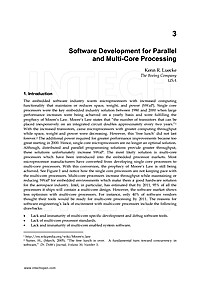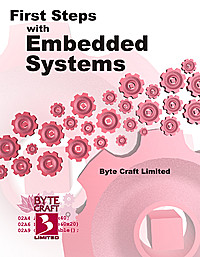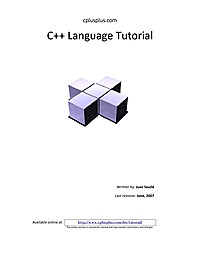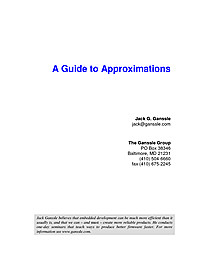
Software Development for Parallel and Multi-Core Processing
The embedded software industry wants microprocessors with increased computing functionality that maintains or reduces space, weight, and power (SWaP). Single core processors were the key embedded industry solution between 1980 and 2000 when large performance increases were being achieved on a yearly basis and were fulfilling the prophecy of Moore's Law. Moore's Law states that "the number of transistors that can be placed inexpensively on an integrated circuit doubles approximately every two years." With the increased transistors, came microprocessors with greater computing throughput while space, weight and power were decreasing. However, this 'free lunch' did not last forever. The additional power required for greater performance improvements became too great starting in 2000. Hence, single core microprocessors are no longer an optimal solution.

First Steps with Embedded Systems
This book is intended to fill the need for an intermediate level overview of programming microcontrollers using the C programming language. It is aimed specifically at two groups of readers who have different, yet overlapping needs. The first group are familiar with C but require an examination of the general nature of microcontrollers: what they are, how they behave and how best to use the C language to program them. The second group are familiar with microcontrollers but are new to the C programming language and wish to use C for microcontroller development projects. First Steps with Embedded Systems will be useful both as an introduction to microcontroller programming for intermediate level post-secondary programs and as a guide for developers coping with the growth and change of the microcontroller industry.
Memory allocation in C
This article is about dynamic memory allocation in C in the context of embedded programming. It describes the process of dynamically allocating memory with visual aids. The article concludes with a practical data communications switch example which includes a sample code in C.

C++ Tutorial
These tutorials explain the C++ language from its basics up to the newest features of ANSI-C++, including basic concepts such as arrays or classes and advanced concepts such as polymorphism or templates. The tutorial is oriented in a practical way, with working example programs in all sections to start practicing each lesson right away

A Guide to Approximations
Most embedded processors don’t know how to compute trig and other complex functions. Programming in C we’re content to call a library routine that does all of the work for us. Unhappily this optimistic approach often fails in real time systems where size, speed and accuracy are all important issues. The compiler’s runtime package is a one-size-fits-all proposition. It gives a reasonable trade-off of speed and precision. But every embedded system is different, with different requirements. In some cases it makes sense to write our own approximation routines. Why?
Memory allocation in C
This article is about dynamic memory allocation in C in the context of embedded programming. It describes the process of dynamically allocating memory with visual aids. The article concludes with a practical data communications switch example which includes a sample code in C.

C++ Tutorial
These tutorials explain the C++ language from its basics up to the newest features of ANSI-C++, including basic concepts such as arrays or classes and advanced concepts such as polymorphism or templates. The tutorial is oriented in a practical way, with working example programs in all sections to start practicing each lesson right away

First Steps with Embedded Systems
This book is intended to fill the need for an intermediate level overview of programming microcontrollers using the C programming language. It is aimed specifically at two groups of readers who have different, yet overlapping needs. The first group are familiar with C but require an examination of the general nature of microcontrollers: what they are, how they behave and how best to use the C language to program them. The second group are familiar with microcontrollers but are new to the C programming language and wish to use C for microcontroller development projects. First Steps with Embedded Systems will be useful both as an introduction to microcontroller programming for intermediate level post-secondary programs and as a guide for developers coping with the growth and change of the microcontroller industry.

Software Development for Parallel and Multi-Core Processing
The embedded software industry wants microprocessors with increased computing functionality that maintains or reduces space, weight, and power (SWaP). Single core processors were the key embedded industry solution between 1980 and 2000 when large performance increases were being achieved on a yearly basis and were fulfilling the prophecy of Moore's Law. Moore's Law states that "the number of transistors that can be placed inexpensively on an integrated circuit doubles approximately every two years." With the increased transistors, came microprocessors with greater computing throughput while space, weight and power were decreasing. However, this 'free lunch' did not last forever. The additional power required for greater performance improvements became too great starting in 2000. Hence, single core microprocessors are no longer an optimal solution.

A Guide to Approximations
Most embedded processors don’t know how to compute trig and other complex functions. Programming in C we’re content to call a library routine that does all of the work for us. Unhappily this optimistic approach often fails in real time systems where size, speed and accuracy are all important issues. The compiler’s runtime package is a one-size-fits-all proposition. It gives a reasonable trade-off of speed and precision. But every embedded system is different, with different requirements. In some cases it makes sense to write our own approximation routines. Why?



















